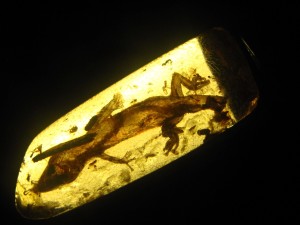 Christian scientists are touting the recent discovery of amber-encased lizards as evidence of a recent creation as described in the Bible.
Christian scientists are touting the recent discovery of amber-encased lizards as evidence of a recent creation as described in the Bible.
Last month, the journal Science Advances published a detailed analysis of amber-embedded lizards, estimated to be approximately 99 million years old. Thanks to the “extraordinary preservation” qualities of the amber, scientists were able to observe intricate details on the lizard specimens.
“Amber deposits are especially useful for preserving small, delicate organisms that are seldom represented as lithified remains or, as fragmentary microvertebrate elements, are often overlooked,” the journal article explains. “This is critical because most lizards are small-bodied.”
A diverse array of species were preserved in the amber, including several that are similar to lizards today.
“In the amber we have things that are clearly gecko,” said Edward Stanley, one of the report’s authors, according to The Christian Science Monitor. “Even 100 million years ago geckos apparently already had evolved a well-diversified subset of tools for clinging onto surfaces.”
The similarity between today’s lizards and these preserved lizards from the past is a tricky subject for evolutionists. Did no evolution occur over those 99 million years?
“The encased organisms show no evidence for evolution between creature kinds,” wrote Brian Thomas of the Institute for Creation Research in an article published last week. “Instead, the dozen lizards fall neatly into five modern lizard categories. For example, the researchers found life-like modern geckos and even identified a tiny chameleon fossil.”
Thomas pointed out that other modern creatures, including scorpions, roaches, ants, and termites, have all been found in the ancient amber, indicating “that no evolution between kinds has happened since their golden entombment.”
“All this amber evidence urges the question: Did the 99 million years really happen?” he wrote.
Thomas believes the amber-encased specimens are best understood through a biblical perspective, where the amber is thousands—not millions—of years old and the lizards are the products of creation—not evolution.
“Only minor variations within basic kinds happen today—and that’s exactly what we see in these amber specimens,” Thomas said. “This means that lizards living with dinosaurs looked like lizards that live today, which fits the Bible’s perspective of recent creation.”
In a similar commentary, Dr. Elizabeth Mitchell of Answers in Genesis rebuts evolutionists’ claims on the preserved lizards, saying evidence for evolution in this discovery simply does not exist.
“There is no evidence for upward evolution through a transitional form in this lizard’s amber tomb—just evidence for the sort of variation that ordinarily occurs within the created kinds of animals God made,” she wrote in an online article published on Friday. “Despite their supposed great age, these lizards, according to the scientists that studied them, display modern features and still have counterparts in today’s Old World tropical forests. Why haven’t 99 million years of evolution changed lizards more? Could it be that they aren’t really so old?”
Furthermore, Mitchell explained, the claim that the amber dates back nearly 100 million years is suspect.
“The age assigned to the amber encasing these lizards should not be accepted because it is based on some assumptions which are not only unverifiable but demonstrably untrue,” she asserted.
“So the lizard collection preserved in Myanmar demonstrates nothing about the reptile evolution over millions of years but only the variations that had developed among the kinds of lizards created by God,” Mitchell concluded.
Become a Christian News Network Supporter...


